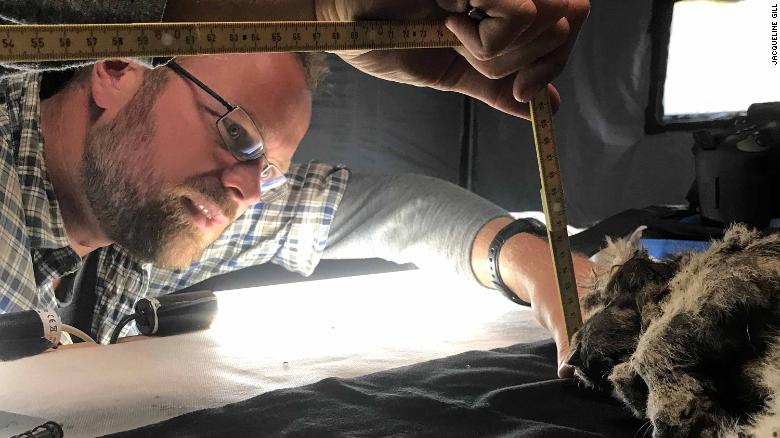Look at the mummy of a lion cub preserved for 28,000 years 0:48
(CNN) -
Looking at her, it appears that the cave lion cub they found frozen deep in the Siberian Arctic appears to be sleeping and could be awakened by one touch.
The puppy's golden coat is covered in mud, but is otherwise intact.
Their teeth, skin, soft tissues, and organs are mummified, but all intact.
Some 28,000 years have passed since he last closed his eyes, and his claws are still sharp enough to prick the finger of one of the scientists who are studying this extraordinary - and unprecedented - specimen preserved in permafrost.
The Siberian Simba, nicknamed Sparta, was one of two baby cave lions - extinct large cats that used to roam the Northern Hemisphere - found in 2017 and 2018 by hunters of mammoth tusks on the banks of the Semyuelyakh River, far away. east of Russia.
Two-headed sea turtle hatchling found on South Carolina beach
The two cubs were initially thought to be siblings as they met only 15 meters apart, but a new study found that they differ in age by around 15,000 years.
Boris, as the second cub is known, is 43,448 years old, according to radiocarbon dating.
"Sparta is probably the best preserved Ice Age animal ever found, and it is more or less intact, apart from the fur being a bit bristled. It even kept the whiskers. Boris is a bit more damaged, but still it's pretty good, "said Love Dalen, professor of Evolutionary Genetics at the Center for Paleogenetics in Stockholm, Sweden, and author of a new study on puppies.
advertising
Both cubs were only 1 to 2 months old when they died, according to the study.
It's unclear how they died, but Dalen and the research team - which includes Russian and Japanese scientists - said there was no sign that a predator had killed them.
A cave lion cub was found in Siberia with its whiskers still intact.
It is over 28,000 years old
CT scans showed skull damage, rib dislocation and other distortions in their skeletons.
"Given their preservation, they must have been buried very quickly. So maybe they died in a landslide or fell into a crevice in the permafrost," Dalen said.
"Permafrost forms large cracks due to seasonal thaw and freezing."
Some 450,000 bees occupied the walls of this house for 35 years.
They just relocated them
During the last Ice Age, Siberia was not the empty place it is today.
Mammoths, tundra wolves, bears, woolly rhinos, bison and saiga antelope roamed along with cave lions, a slightly larger relative of African lions living today.
It is not known how the cave lion adapted to life in the harsh high latitudes, with their rapid seasonal changes, strong winds, and cold, dark winters.
The study, published in the journal
Quaternary
, found that cave lions' fur was similar to but not identical to that of an African lion cub.
Ice Age cubs had a long, thick undercoat of fur that may have helped them adjust to cold weather.
This is how a dog reacted to being abandoned (ends well) 2:11
Fang hunters
In recent years, mummified remains of a number of extinct animals have been found - a woolly rhinoceros, a lark, a cave bear, a canine cub - that once roamed the Russian steppe, often by hunters who destroy tunnels using high pressure water hoses in the permafrost mainly looking for long curved mammoth tusks.
There is a lucrative - albeit controversial - trade in tusks, which are prized by ivory carvers and collectors as an alternative to elephant ivory.
Wildfires in Siberia and Canada are more intense than before, experts say
Russian scientists such as Valery Plotnikov, co-author of the study and researcher at the Academy of Sciences in Yakutsk, the main city of Siberia, have accompanied and developed working relationships with the tusk hunters, who discover amazing finds in the mud and ice of the permafrost. .
"In 2017 ... I worked with them in the hole, the ice cave," Plotnikov said in a podcast produced by the Natural History Museum in London that was published last month.
"It is very cold, it is very dangerous and very hard to work, terrible conditions, many mosquitoes," he added, saying that he lost 10 kilos in the month he spent with the tusk hunters.
But the relationships he forged have spawned a scientific bonanza: Plotnikov said he has encountered cave lion cubs, a wolf's head and a family of mummified mammoths.
Love Dalén measuring Sparta, the cave lion cub found frozen in the Siberian permafrost.
The climate crisis has also played a role.
Warmer summers - the Arctic is warming twice as fast as the world average - have weakened the permafrost layer and lengthened the tusk hunting season.
"Definitely more finds are being made these days. The main reason is the increased demand for mammoth ivory, which means that more people are looking in the permafrost. But climate change is also contributing, causing the melt season. (and therefore the fieldwork) takes longer, "Dalen explained by email.
Climate change is producing deadly heat waves.
Why don't we see it as a crisis?
Scientists have to analyze the frozen remains for infectious diseases that may lie dormant, such as anthrax, before examining them in detail, although Dalen said the remains were unlikely to harbor ancient pathogens.
The pups' sex was confirmed by CT scan and genetics-based sex determination.
Dalen said the next step would be to sequence Sparta's DNA, which could reveal the cave lion's evolutionary history, population size and unique genetic characteristics.
Excessive heat in Siberia is the product of man 0:56
Animals

